
Akhil Bhartiya Kutch Kadva Patidar Samaj
A central organisation of Kutch Kadva Patidar Sanatan community

Akhil Bhartiya Kutch Kadva Patidar Samaj
A central organisation of Kutch Kadva Patidar Sanatan community
Translation Status: Pending – To Review
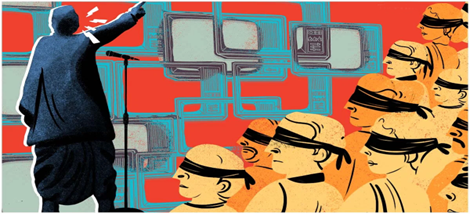
17. What the “Destruction of Ideology” (Ideological Subversion) means: It is not wise for an invader to engage in direct combat when they are outnumbered or outmatched. Throughout history, invaders have employed a strategy known as “Destruction of Ideology” in such situations. This strategy involves undermining the beliefs and values of the opposing side, rather than engaging in direct conflict.
VERY IMPORTANT It is crucial to carefully read this chapter to fully comprehend the critical seriousness of how K.K.P community was on the brink of extinction due to the “Destruction of Ideology” and how it eventually returned to Sanātana dharma. |
|
Ideological Subversion Experts doing research on the causes of the Collapse of Civilization, Religion, Culture and Nation say: A best strategy for warfare involves not engaging in direct combat, but rather systematically dismantling the enemy’s sources of strength, pride, importance, and value through means such as corruption. This process should be continued until the enemy’s perception of reality is corrupted or destroyed, ultimately leading them to no longer view you as an adversary. It is important to note that some people may view the civilization, religion, and ambition of an invader as an alternative and even desirable enough to adopt. This is the Ultimate Purpose, the final stage of destroying thought. With ease, you can now eliminate the enemy without firing a shot. |
18. How does Ideological Subversion work? Professional propagandists, experts on the subject, describe ideological subversion as the destruction of ideology in four phases.
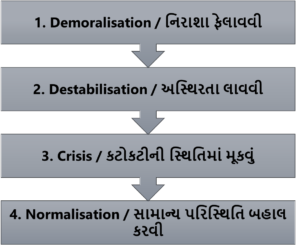
19. Demoralisation: In simple words, spreading frustration. This means to exert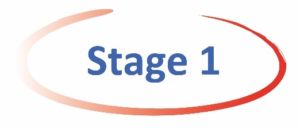 pressure or act in such a way as to distract the opponent and put him in an unstable situation which can be done in three ways.
pressure or act in such a way as to distract the opponent and put him in an unstable situation which can be done in three ways.
1) Overt: Focus on direct efforts that are conducted in public view.
2) Legitimate: It is generally considered valid and appropriate to make these efforts, as long as no laws are violated.
3) Easily Observable: The work that takes place in this category can be easily observed and judged. We simply need to take time out and work a little harder to see it. These actions are not defined as crimes according to government rules and the law and order of the country. It usually consists of activities like spreading misunderstandings and changing the terminology of words very cleverly, etc.

It takes a long time for a new ideology to spread and take hold in a society. At least three generations are needed to explain and instill the new beliefs in people and shape their personalities accordingly. Only then can the new ideology become widely accepted. This is because the previous generations, who are familiar with the old ways, need to pass away before the new ones can take hold. If the original awakening is still ongoing, even more time may be needed to fully spread the new ideology. To accomplish this, various methods can be employed, such as outreach, publicity, direct contact, and others. These methods can be used to manipulate people’s opinions to the advantage of the aggressor.
20. Main Areas of Demoralization: This stage is of utmost importance and serves as the foundation for the destruction of ideology. The main focus of this phase is to utilize original ideas, opinions, and views of individuals to shape and mold them into a new form. The key areas of focus involve reshaping and remolding these ideas to create something innovative and unique.
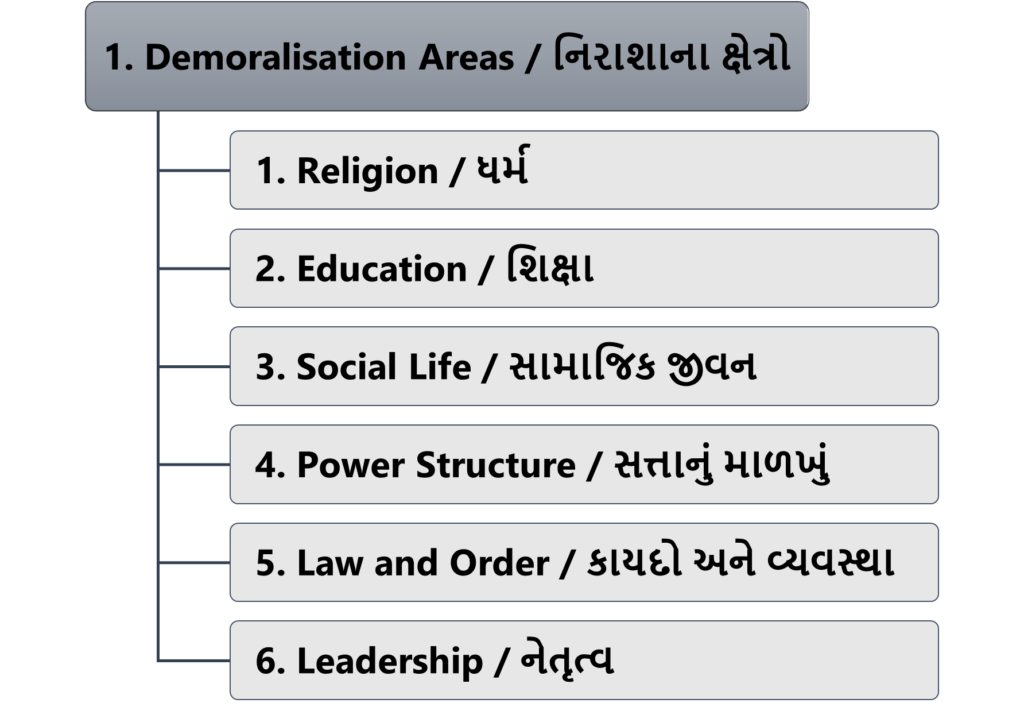
We will now see what is being done in each of the above-mentioned areas.
20.1. Religion: In this region, religion is often disrespected and made into a source of mockery. It is sometimes altered or distorted from its original roots in order to form a cult or sect. The resulting sect or creed may be flawed, underdeveloped or lacking in true religious values.
It is important to gradually erode the faith, values, ideals, and principles (religious dogma) of people’s original religion. This is done to free people from their original religion. However, this approach undermines the ultimate purpose of religion, which is to connect people directly with God. Therefore, attention should be given to the harmful effects of this erosion on people’s ability to connect with their spiritual beliefs.
In order to achieve their goals, fake/fradulent organizations may try to replace legitimate and respected religious organizations. They do this to divert people away from the true and original faith, and instead motivate them to join other sects or cults that are not aligned with the true purpose.
To see how this issue affected K.K.P community, see point (68).
20.2. Education: It’s regrettable that some individuals are misguided and deprived of a practical, efficient education. Instead of focusing on crucial subjects like mathematics, science, language, history, and religious texts, they are taught broad generalizations that may lead them astray. Frequently, genuine information is substituted with basic teachings like personal hygiene, healthy eating and drinking habits, and honesty in business dealings.
To keep people away from the original (true) education as mentioned above, the oppressors keep pretending to give true teaching by talking pointlessly about practices that common people already know and follow.
20.3. Social Life: During this phase, there is a shift away from traditional institutions, associations, and societies towards false ones. The goal is to suppress people’s initiatives and break the natural bonds that tie individuals, groups, and society together, as well as those responsible for upholding and sustaining society. Instead, certain individuals may be appointed as leaders in the name of a chosen Amaldar, and they may be given control and authority over the society or organization.
Institutions are established to replace social life and friendship among individuals, where only their own people are appointed.
In some communities, family disputes are usually resolved by family members. However, in certain cases, the responsibility of resolving these disputes is entrusted to the head of Jamaat-Khana, also known as Khana. As a result, it is essential for everyone to have a good relationship with the Khana’s head to prevent any conflicts. This practice can lead to an increase in the Khana’s head authority and power, which may enable them to maintain control over the community members.
20.4. Power Structure: Instead of following a traditional administrative system, where people are chosen or elected to hold responsibilities, a new system has been introduced. This system allows oppressors to directly appoint individuals to positions of power, instead of them being selected or appointed by the people or the society.
The structure of social authority is slowly being eroded by incompetent/unqualified people who lack the necessary skills and lack the trust of the people. Such people have power even if the people have not chosen to give them power.
Take the media, for instance. They are a group that wields significant power, despite having no official appointment. The media has a profound effect on our hearts and minds and has largely monopolized this influence. They can manipulate our emotions and thoughts at will. However, who gave them this authority? They tend to dictate what is right or wrong for us.
Note: This is just an example to explain the social order regarding the above-mentioned point. Not a comment on any particular media. Special request to not misunderstand this in any way.
There are several examples of religious organizations that have a significant impact on their respective communities. For instance, in the Hindu community, we have organizations such as RSS, BJP, VHP, Bajrang Dal, and Sadhu organizations. Similarly, in the Muslim community, we have Mullahs, PFI, SDPI, Wakf Board, and their Farmans. Christian organizations also have their churches, religious education institutions, and hospitals. I believe the readers can understand the point I am trying to convey, so I won’t elaborate further here. In the next section, we will examine specific examples of such organizations.
For how this issue affected the K.K.P community, see points (76 and 77).
20.5. Law and Order: In this phase, the infrastructure of law enforcement and administration of law and order is eroded.
It is common to see negative portrayals of police officers in films from the past 50 years. They are often depicted as corrupt, angry, and failing to serve the public. Meanwhile, criminals are portrayed as powerful and influential. This creates a general impression that police officers can be bought or influenced, and are not fulfilling their responsibilities. Similarly, we are constantly exposed to cases of politicians being corrupted or acting in their own self-interest.
Due to corruption in the police and the courts, people often do not receive the justice they deserve, even when the evidence is crystal clear. This leads to harassment, exhaustion, and ultimately silence for the victims. The corrupt system is upheld by politicians, law enforcement, and the administration, allowing oppressors to maintain their power while innocent people are suppressed.
The individuals responsible for ensuring safety and upholding the law should be trusted rather than distrusted.
It is unjust to apply different moral standards to individuals based on their status in society. For instance, some may argue that a terrorist who resorts to violence has been pushed to do so due to extreme torture, and therefore, his actions can be justified. However, when a common man commits a similar act, they are often subjected to harsher condemnation and punishment. Such a double standard in morality is unfair and should be avoided.
It’s possible for individuals to manipulate or distort fundamental moral principles to serve their own interests. Even when actions may be considered criminal, some people will claim that they were simply acting in self-defense rather than acknowledging their guilt. Additionally, constantly casting doubt on what is true can leave those in positions of power feeling uncertain and confused when making important decisions.
In certain situations, a fake witness can present a false affidavit and it will be accepted as true. However, if an honest individual presents a certificate that exposes the truth about an oppressor, false accusations are often spread claiming that the certificate was obtained through dishonest means for financial gain.
For how this issue affected K.K.P community, see points (76 and 77).
20.6. Leadership: In this phase mentioned in point (19) above (regarding at least three generations), the relationship between the Gurus, leaders and intellectuals of the traditional native religion (such as the Brahmins) and their followers is gradually destroyed.
Due to this, the connection with the source of education/knowledge/understanding about the original religion and society is broken.
Instead of the current leadership, a new one should be established as the true leader of the original religion. This new leadership’s purpose is to address questions and problems that arise within the original ideology, while also providing suggestions that align with the new heretical ideology. To do this, examples – both true and false, even if irrelevant – from the original ideology should be presented to the followers, conditioning them to view the original ideology with suspicion. This subtle manipulation of the followers’ beliefs will ultimately cause instability to take root, leading to a permanent state of suspicion towards the original ideology.
For how this issue affected the K.K.P community, see points (76 and 77).
20.7. Total Demoralisation: Once the aforementioned phases or steps have been reached, the country, society, and civilization fall into a state of complete misery. This creates a situation where it’s difficult to distinguish between what is right or good, and what is wrong or bad. The line between right and wrong becomes blurred, and even the original ideological leaders, heads, or sadhus become so impressed that they may speak in favor of heresy once in a while.
For instance, the renowned storyteller of Ramayana, Murari Bapu, was compared to the legendary figure of Ali, a hero of Islam. This created confusion among the general Hindu populace, as they were unsure whether to adhere to their own traditional Hindu beliefs or the divergent Islamic beliefs. As a result, they lost the ability to discern what was right or wrong.
When this happens, Demoralisation is considered complete.
21. Destabilization: The task of destabilizing traditional relationships, contacts, 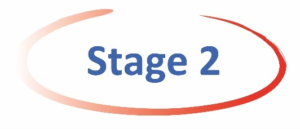 slogans, organizations, and institutions of a targeted group should only be carried out by insiders.
slogans, organizations, and institutions of a targeted group should only be carried out by insiders.
As we enter this phase, the available workspace is reduced. It is worth noting that the practical, justified and easily identifiable measures mentioned in the previous stage, known as the “Demoralization” stage referred to in point (19), have been embraced by individuals as a natural part of life.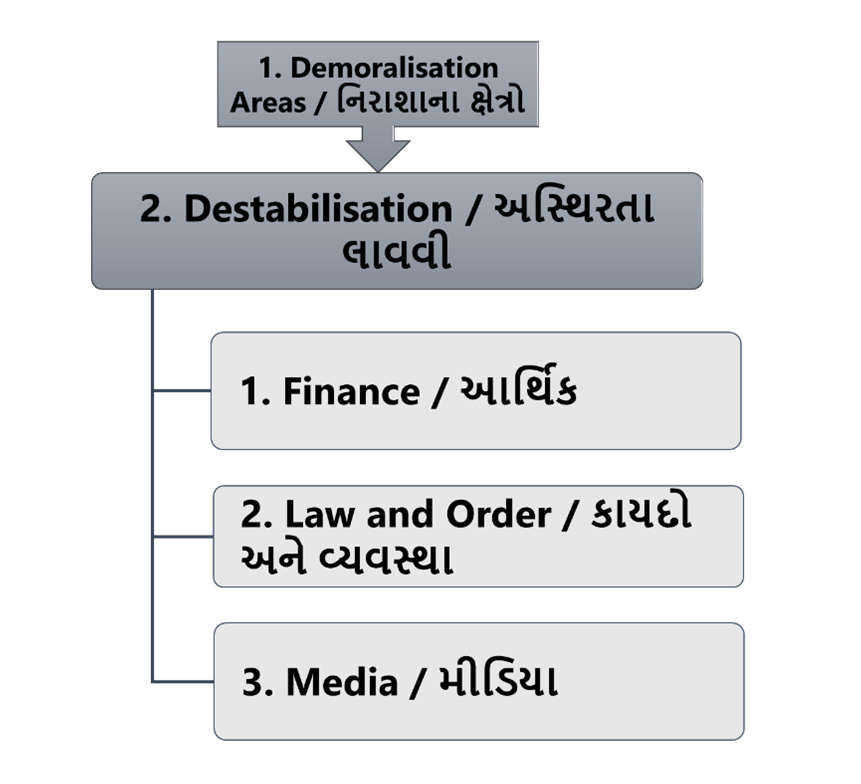
PENDING – Paragraph misssing – Point (19)
Spreading heresy is not considered a crime. Similarly, promoting or supporting the Satpanth religion in Sanatan society may not be illegal, but it is deemed to be a moral transgression. However, when stability is established in society, an environment is created where individuals are free to practice any religion of their choosing. At this point, the propagation of heresy or Satpanth in Hindu society becomes more acceptable and easily accepted by the people. Ultimately, such actions are no longer considered moral crimes.
supporting the Satpanth religion in Sanatan society may not be illegal, but it is deemed to be a moral transgression. However, when stability is established in society, an environment is created where individuals are free to practice any religion of their choosing. At this point, the propagation of heresy or Satpanth in Hindu society becomes more acceptable and easily accepted by the people. Ultimately, such actions are no longer considered moral crimes.
In this stage, work that was once considered a moral crime is now accepted.
21.1. Finance: During this phase, the financial stability of a society, community or country is severely affected leading to an economic crisis. Economic burdens like religious taxes and levies, imposed through shraddha and andshraddha, are introduced with the intention to cause financial distress. Fear is instilled among those who do not pay, warning them of dire consequences like being denied a place in heaven or ending up in hell.
Charitable organizations rely on idealistic messages to convince people that religion is effective and that the prayers of the needy will be answered. These organizations run both small and large programs, often with the help of volunteers who are motivated to work for free. However, there is a risk that manipulative individuals may use donated funds to stage events and gain influence over the community.
21.2. Law and Order: In this step, the law and order situation is also controlled. The time has come to create a web of suspicion as mentioned in the previous point (20.5). In order to accomplish this, spread false information about the police, courts, and political system, alleging corruption and a lack of justice.
Create a sense of fear among the people that the law and order system is under the control of the oppressors. This way, if someone tries to report the oppressors to the police or the court, they will feel that their efforts will go in vain and it won’t bother the oppressors. Consequently, the oppressors can continue to manipulate and deceive people into believing what they say is true.
21.3. Media: Media is also managed in this phase. Public media should be bought with money. Media reporters are constantly bombarded with literature and propaganda materials loaded with pro-issues. Providing big advertisements to media houses to publish favorable articles and news is also important. The concept of paid news should be utilized as well. In public, their ideology is portrayed as right and good while those who oppose them are depicted as wrong and selfish. This sends a message to the common people that those who oppose them are not doing anything good.
22. Instability spreads:
22.1. Bigotry in Relationships: Bigotry and intolerance often create irreconcilable differences in relationships, leading even family members to be at odds with each other. For instance, a father and son may fail to come to a consensus regarding their respective religious or ideological beliefs. If the son wishes to follow Sanatan, the father may refuse to let him abandon Satpanth. Similarly, if a husband expresses a desire to practice Sanatan, his wife may threaten divorce, thereby sparking a heated argument.
In both trivial and important matters, there is a growing atmosphere of opposition in society. Everyone seems to be fighting, and disputes are often taken to court. Even in normal relationships, the number of quarrels has increased significantly. Those who fight for the oppressor’s ideology are sometimes celebrated as heroes, but they should be made aware that their own ideology is fundamentally flawed. Instead of spreading harmful ideas, they can truly become heroes by promoting positivity and compassion.
22.2. Mawalo: Currently, the Mawalo (Sleeper Cells) have been activated and located at point (192). Over the years, these Mawalos have successfully infiltrated and established themselves as members of the Sanatan Samaj. Although they publicly identify as members of Sanatan Samaj, their true beliefs lie with Satpanth, and they secretly donate to Pirana. In situations where a decision may negatively impact the Satpanth in the village, they deceive people by using false ideals and superstitions to ensure Satpanth’s existence continues in society.
The Satpanthis followed a similar pattern of behavior whenever they encountered a leader of Sanat. They made an effort to engage in friendly conversations and develop close relationships with them. For instance, they pretended to be a history student interested in learning about the past and shared similar views. They frequently found ways to meet with the Sanat leaders under the pretext of learning. However, in reality, their goal was to uncover any weaknesses of Sanat’s leaders, which they could exploit to influence and deceive them. If any weaknesses were discovered, they would take advantage of them and suppress the voice of Sanat leaders.
There are sleeper cells that remain dormant for years, only to emerge as leaders of the original ideology. Their aim is to weaken and paralyze the original ideology, while mobilizing support to bring about the collapse of society.
During this phase, the individual who aims to disrupt society is already a part of it. There is no need to bring in anyone from the outside. This insider often appears to be a respectable member of society and may even receive financial assistance. If you observe closely, you will notice that once a person gains a certain position in a society or religious institution, their financial strength suddenly increases significantly. It begs the question, can such an individual ever be completely truthful with you?
22.3. Result: At the end of this stage, the society experiences a state of crisis due to increased instability.
23. Crisis : A crisis occurs when a society or organization is unable to carry out its 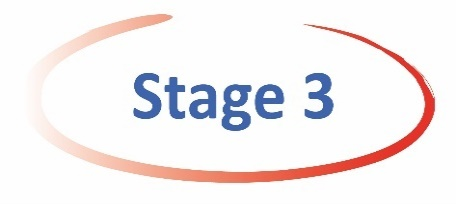 expected functions and eventually falls apart. During this phase, the general public is usually tired and worn out. The economic situation of the people deteriorates, and the society fails to make progress compared to others, remaining significantly underdeveloped.
expected functions and eventually falls apart. During this phase, the general public is usually tired and worn out. The economic situation of the people deteriorates, and the society fails to make progress compared to others, remaining significantly underdeveloped.
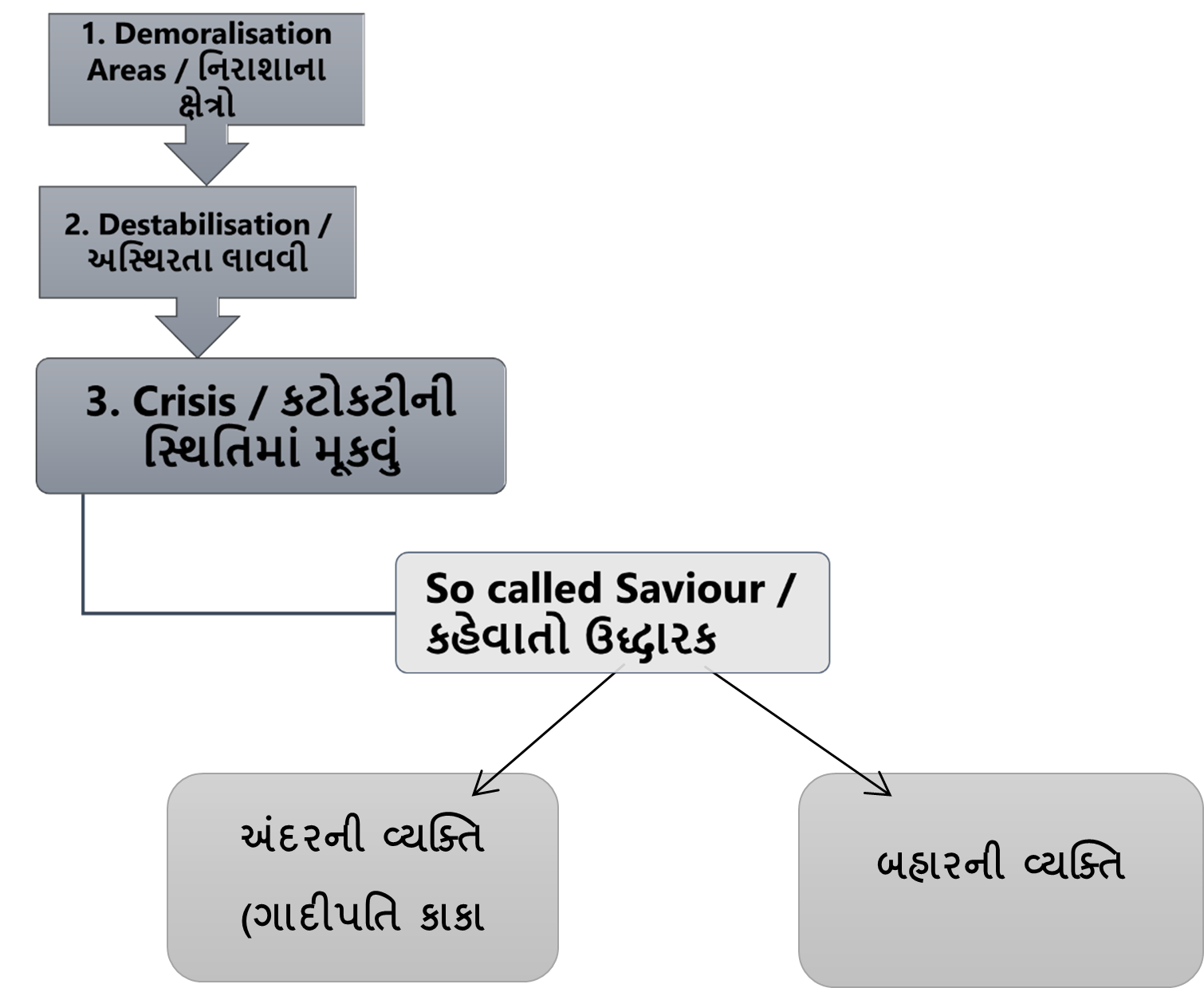
During times of crisis, people often yearn for a savior or rescuer to lead them out of the situation. Some may wait for a great leader to emerge and guide society towards recovery, while others may hope for the arrival of a religious figure such as a monk or saint to liberate them.
23.1. This stage typically occurs when the institutions that are meant to serve the people have stopped functioning effectively. In situations where an elected leader is unable to carry out their duties, intervention from external organizations may be necessary. At this point, an outsider may step in to take on a leadership role and make decisions on behalf of the community.
Similar to criminals and corrupt politicians, there are new groups of sadhus who emerge and claim to have solutions to all the problems. However, these individuals are often unknown and are only seeking to spread their own fabricated ideology. During this period, it is crucial to separate the tangled mixture of religion and ideology.
sadhus who emerge and claim to have solutions to all the problems. However, these individuals are often unknown and are only seeking to spread their own fabricated ideology. During this period, it is crucial to separate the tangled mixture of religion and ideology.
23.2. Here, fictitious institutions, organizations and individuals come into play and claim that they have all the powers necessary to bring about a solution. Even if they are not allowed admission into society, they keep sending recommendations through their agents.
Often, individuals who lack proper education and intellectual capacity consider themselves capable of providing solutions to various societal issues. However, they may not have even an average level of education from a reputable institution abroad.
23.3. Sankat Mochak / Uddhadark / Liberator: Now, a person known as Sankat Mochak enters the scene with the intention of rescuing people from the crisis. This individual could be someone from within the society, a pre-embedded sleeper cell referred to in point (22.2), a respected member of the community like Gaadipati Mujawar Kaka [85:Page 23], or someone from outside the community who has been granted admission.
The society or social group has been significantly weakened as a result of continuous “Ideological Subversion”. This state of “Demoralization” has caused the group, which was once firmly rooted in its original ideology, to lose its sense of direction. Consequently, they are no longer able to distinguish between right and wrong.
During the phase of “Destabilization”, society and individuals are left in a state of chaos. People tend to accept anyone who claims to solve their problems when they see no hope. This gives immense power to those who call themselves “Sankat Mochak”. |
|
Completely trapped in the cycle of “ideological destruction”, with no hope of escape. For instance, a portion of the Lohana community in Hinduism. | The trick |
For centuries, the scriptures of the Satpanth religion mentioned Hindu deities like Allah, Ali, and the Nishkalanki Narayan alongside Hinduism’s gods. As a result, many people considered Satpanth to be a part of Hinduism, and their forefathers followed it as the true Hindu religion of Kali Yuga. However, the scriptures of Satpanth suggested otherwise, causing a crisis of identity within their society. During this time, Aga Khan arrived and established himself as the Nishkalanki Narayan, leading to the loss of control of their society from the Lohana community. Today, this society is known as the Khoja Muslim Samaj. The normalization phase followed, where foreign and heathen ideologies were integrated.
24. Normalization: In this phase, foreign/external/heathen ideology gets  established. In other words, the feelings, words and deeds of community, society or country are completely changed. People are permanently alienated from the original ideology.
established. In other words, the feelings, words and deeds of community, society or country are completely changed. People are permanently alienated from the original ideology.

24.1. After the reins of the society/caste/community/country are in the hands of the so-called insurgents, the factors destabilizing the society and putting it in crisis should be removed. The normal life of the people should gradually be made to run as normal. There should be no quarrels or disputes. But there is one major difference now. The difference is that the society/caste/community/country is completely alienated from its original ideology and has adopted the ideology of invaders/heretics.

24.2. Now, the existence of sleeper cells is abolished. As those people have completed their work, they are no longer needed. New powers need stability. Only then can it sustain its power. Work should be done to uproot the old ideology. The adulterated, corrupt teaching is now phased into the teaching of heretical ideology. The new generation is turned into fanatics by placing a sense of immense pride in this new heretical ideology which is now accepted as their own ideology. This causes the new generation to be ready to do whatever it takes to protect the new heretical ideology. Even if countless proofs are placed before them, they are not ready to accept it.
24.3. The Satpanth community serves as an interesting example. It is alleged that after Aga Khan took control of the Khoja community, he eliminated the children of the community. His power was only consolidated after the assassination of his four strongest opponents in Mumbai [141:Page 32]. Originally, Satpanth was believed to be the true Hindu religion of Kali Yuga, but over time, the Hindu gods were gradually removed from the religion’s scriptures, and all connections with Hinduism were eventually severed. Aga Khan organized a conference in Paris in 1975 [140] to replace Vishnu’s Dashavatar Granth, a religious text written by Imamshah and Pir Sadruddin, with the Islamic Qur’an as the primary religious text [140:Page 105 Dat 106].
25. Significant: It’s important to remember that not everyone may have the hindsight, knowledge, and understanding of the tactic or strategy of ideological destruction mentioned earlier. However, people may still work towards it by exploiting the general tendency of humans to react. It’s important to understand how propaganda works. It involves a continuous stream of messages through various media channels, along with a persistent flow of ideology. The aim is to influence the way people think and behave, regardless of whether the propaganda is true or false. Take for instance, how Rahul Gandhi is currently spreading misinformation during his foreign visits, claiming that the Indian Constitution is in danger and there’s no freedom of speech in India. These falsehoods are designed to manipulate people’s reactions and shape their opinions. | |
Many believe that they have the freedom to practice any religion they choose. However, the reality is quite different. The ability to choose a religion has been taken away from people through deceptive tactics. Propaganda and biased media outlets are used to undermine the legitimacy of law and order, leading people to believe in a heretical ideology that is presented as the true religion. This misinformation can lead people to make decisions that are not in their best interest. |
26. Inequality in Rules: It’s important to note that the process of “destruction of ideology” within a community does not involve all members at the same stage. Some may be at an initial stage, while others are at an advanced stage. However, most members of the community are likely at a particular stage of the process. Therefore, it’s possible to observe some members being very passionate about a particular subject, while others may be more mild-mannered, indicating different stages. Ultimately, it’s important to consider the actions of the community as a whole.
It is necessary for society to have strict rules in certain areas while being more flexible in others. In such cases, it would not be fair to apply the same punishment to everyone. However, as heretical ideologies lose their influence, rules become more uniform. This is the fundamental principle of social and community development. Therefore, it is important for everyone to keep this in mind and strictly adhere to the rules that apply to them.
27. Monitoring the changes / Tracking table: The following table has been prepared from all the above-mentioned stages so that we can monitor the changes and their impact in each stage and track them.
Oversee changes / Tracking table | ||
Ideological Subversion | Destruction detail | |
1. Demoralisation Areas | 19 | |
| 1.1. Religion | 20.1 |
| 1.2. Education | 20.2 |
| 1.3. Social Life | 20.3 |
| 1.4. Power Structure | 20.4 |
| 1.5. Law and Order | 20.5 |
| 1.6. Leadership | 20.6 |
2. Destabilisation | 21 | |
| 2.1. Finance | 21.1 |
| 2.2. Law and Order | 21.2 |
| 2.3. Media | 21.3 |
3. Crisis | 23 | |
| 3.1. So-called Saviour | 23.3 |
| • The insider |
|
| • An outsider |
|
4. Normalisation | 24 | |
| 4.1. Establishing a new society – in 2 steps |
|
| ||
Special Note: Please give special attention to the table above. This table will be referenced frequently to understand the history accurately.